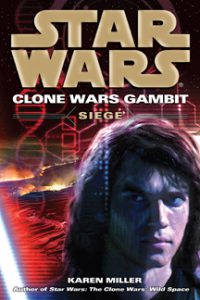By the time of Karen Miller’s third “Star Wars” book, “Clone Wars Gambit: Siege” (2010), we know the game: Strap in for a lot of words, but you’ll be rewarded with outstanding characterization and an appreciation for the human toll of warfare.
I remembered “Siege” as the novel where Anakin and Obi-Wan are holed up in a village (Torbel) on a backwater planet (Lanteeb) for endless pages of grueling prose. Indeed, this takes up most of the 382 pages. It’s hard to recall a more brutal test for any “Star Wars” heroes: After their evasion of General Durd in the duology’s first book, “Stealth,” they arrive at this meager village at death’s door. It’s clear that any non-Jedi would be dead, but they have to draw on more of their superhuman reserves in order to work in the damotite mines, shore up the shields and power plant to keep the Separatist army at bay (Anakin) and restore peoples’ health with their powers (Obi-Wan) – all the while hoping that the villagers won’t turn them over to the Separatists. And while subsisting on terrible-tasting food and severely rationed water.
But I liked this the best out of Miller’s three books because she does grant us some reprieves of additional threads. Granted, when Bail Organa and Yoda are discussing Lanteeb war policy with Supreme Chancellor Palpatine, we know it won’t move the plot forward. However, we get some juicy moments of Palpatine/Sidious barely keeping his rage at bay when he learns about certain failures of Dooku and Durd from his Republic advisers. And also when he learns that Yoda and Bail have declined to tell him about Anakin and Obi-Wan’s stealth mission. We see that Yoda is already suspicious of Palpatine, even before the big reveal in “Revenge of the Sith.”
In addition to fleshing out the relationships of the main movie/”Clone Wars” characters (we also see Ahsoka and the 501st grow closer), Miller gives us some characters that are unfortunately confined to “Gambit.” A Lanteeban girl, Greti, has Force ability, and Obi-Wan uses her to help him heal villagers, all the while knowing she won’t be trained as a Jedi, let alone rescued from her lot in life. Like all isolated Lanteebans, she’s been raised with racist ideas, yet when she meets the red-skinned, no-haired Ahsoka, she asks if she can visit Togruta someday. It’s a sweet moment that shows kids’ curiosity can quickly cause their teachings to crumble.
Taria, introduced in “Stealth,” is Obi-Wan’s (not so subtle anymore) love interest – when Anakin realizes this, it leads to his introspection about Obi-Wan’s hypocrisy, plus a verbal confrontation. (While Anakin is technically no longer Obi-Wan’s Padawan, Miller nonetheless delivers some of the best writing out there about their master-student relationship.) Taria, who also serves as a mentor to Ahsoka while she’s separated from Anakin, is an optimistic character living a fatalistic arc; she has the GFFA equivalent of terminal cancer. Oddly, she does not die at the end of this book, and she never appears in another.

Further evidence that Miller planned more “Clone Wars” stories (this ended up being the last published “Clone Wars” spinoff novel) comes through Durd. After two books of brutalizing his kidnapped scientist Bant’ena (who creates the deadly damotite-based bioweapon out of fear for her family’s safety), Durd – as we’re told in a throwaway line – flies up to Grievous’ ship and escapes. We miss out on what should have been a satisfying scene of the gluttonous Neimoidian getting what’s coming to him. I imagine Miller had more planned for this villain, or that she was told not to kill him off because the TV series had more planned for him, but he never appears again in the Legends timeline. (Since the TV series is part of the Disney canon, it’s theoretically possible that Durd’s narrative could continue in “Rebels” or another venue, although in that timeline he is in Republic custody at the end of his last TV appearance.)
Not that I’m asking for “Siege” to be any longer, but I wouldn’t have minded if some of the chapters of Obi-Wan and Anakin suffering were replaced with pages from the perspective of the cobbled-together non-GAR fleet (having been formed by Bail and Padme) that assists Admiral Yularen’s meager complement at Lanteeb. The idea of planetary or coalition militaries participating in the Clone Wars was also briefly broached in “Jedi Trail” in the form of a group that defects from the GAR and wages its own war against the Separatists. In that book and this one, I would’ve liked further exploration of Palpatine’s feelings about these outside elements messing up his chess board.
In one quick insight, we learn that Yularen – later an Imperial admiral – hates working with military forces other than the Grand Army of the Republic. Indeed, he seems to believe the very existence of local militaries should be illegal.
As with “Wild Space” and “Stealth,” Miller’s “Siege” is not your typical rip-roaring “Star Wars” adventure. The plot is simple and slow-moving, and our heroes are pushed to insane physical and psychological limits. If you read Miller’s books, though, you’ll find the “Clone Wars” and its heroes and villains feel more substantial than they do in any given TV episode. In that sense, these supplementary novels are essential.

